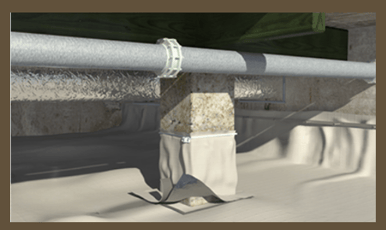The Vital Role of Vapor Barriers in Crawl Spaces

In the battle against moisture and its potential hazards, a vapor barrier stands as a crucial line of defense. A vapor barrier is a protective sheet of material, often polyethylene plastic, designed to halt moisture from infiltrating spaces like crawl spaces, basements, and attics. However, let's delve further into the importance of vapor barriers in crawl spaces and explore their various benefits and risks.
-
Enhanced Protection Against Mold and Dampness: Crawl spaces are notorious for their damp and humid conditions, creating an ideal breeding ground for mold and mildew. Without a vapor barrier, moisture seeps in from the ground, gradually saturating the crawl space. By installing a vapor barrier, you create a barrier that hinders moisture intrusion, thereby reducing the risk of mold growth and keeping your crawl space dry and healthy.
-
Improved Energy Efficiency: The condition of your crawl space can significantly impact your home's overall energy efficiency. When left unaddressed, a damp crawl space can lead to increased humidity levels, affecting the indoor climate and making it harder for your HVAC system to maintain comfortable temperatures. A vapor barrier helps regulate moisture, ensuring your crawl space remains dry, and consequently, enhancing the energy efficiency of your entire home.
-
Safeguarding Your Home's Foundation: Moisture-laden crawl spaces can wreak havoc on your home's foundation. Prolonged exposure to moisture weakens the structural integrity of concrete and may lead to cracks or other forms of damage. With a vapor barrier in place, you minimize the risk of water seepage and protect your foundation from costly and extensive repairs.
Get a High-class Vapor Barrier!
Choosing the Right Vapor Barrier: When considering vapor barriers, you'll come across two primary types: Class I and Class II. Class I barriers are more effective at blocking moisture, but they tend to be pricier. On the other hand, Class II barriers offer a more budget-friendly option, though they may not be as adept at preventing moisture intrusion. The choice between the two depends on your specific needs, budget, and the overall dampness of your crawl space.
Class 1 and Class II vapor barriers are classified based on their permeability rating, which is a measure of how easily moisture can pass through a material. A lower perm rating means that the material is less permeable to moisture.
- Class 1 vapor barriers: Have a permeability rating of 0.1 perm or less. These are the most effective at preventing moisture from passing through. They are typically used in areas where moisture control is critical, such as crawl spaces and basements.
- Class II vapor barriers: Have a permeability rating of greater than 0.1 perm and less than or equal to 1.0 perm. These are less effective at preventing moisture from passing through than Class 1 vapor barriers, but they are also less expensive. They are typically used in areas where moisture control is not as critical, such as attics and walls.
ASTM-E 1745 is a standard that defines the test method for determining the permeability of vapor barriers. This standard is used to measure the perm rating of vapor barriers.
The following table summarizes the key differences between Class 1 and Class II vapor barriers:

Installation and Maintenance: Proper installation of the vapor barrier is vital for its effectiveness. Thoroughly clean the crawl space before laying down the barrier, ensuring no debris or contaminants compromise the seal. Overlap the seams by at least 6 inches to create a continuous barrier, and securely fasten the material to walls and floors using duct tape or an appropriate adhesive.
Regular maintenance of your crawl space and vapor barrier is essential to maximize its lifespan and effectiveness. While the longevity of a vapor barrier varies depending on material and conditions, it's generally recommended to replace it every 10-15 years.
The Consequences of Neglect: Choosing not to use a vapor barrier in your crawl space exposes your home to several risks. The lack of a vapor barrier can lead to:
-
Mold Growth: Unchecked moisture levels foster mold growth, endangering your health and home's structure.
-
Foundation Damage: Water infiltration weakens your home's foundation, potentially leading to extensive and costly repairs.
-
Reduced Energy Efficiency: Damp crawl spaces impair energy efficiency, resulting in higher utility bills.
In conclusion, a properly installed and maintained vapor barrier is an indispensable asset in protecting your crawl space and your home. By preventing moisture from seeping in, a vapor barrier ensures a healthier, more energy-efficient environment, safeguarding both your family's well-being and your home's longevity. Invest in the right vapor barrier today and enjoy the peace of mind it brings for years to come.


